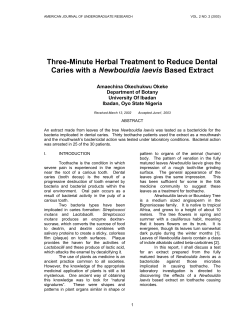
Candida glabrata Sometimes a problem, sometimes not…
Candida glabrata Sometimes a problem, sometimes not… C andida glabrata, once known as Torulopsis glabrata, is a common nonhyphae forming yeast isolate in the clinical laboratory. It is a member, along with over 200 other species, of the Candida genus. Jay Hardy, CLS, SM (ASCP) Jay Hardy is the founder and CEO of Hardy Diagnostics. He began his career in microbiology as a Medical Technologist in Santa Barbara, California. In 1980, he began manufacturing culture media for the local hospitals. Today, Hardy Diagnostics is the third largest media manufacturer in the US. To ensure rapid and reliable turn around time, Hardy maintains six distribution centers, and produces over 2,700 products used in clinical and industrial microbiology laboratories throughout the world. Habitat Candida spp. are ubiquitous inhabitants of the gastrointestinal tracts of mammals. According to one study, in the human GI tract, the most commonly isolated species would be in the following order: C. albicans C. tropicalis C. parapsilosis C. glabrata However, some references list it as the second most commonly isolated Candida organism from GI sources. C. glabrata can be routinely isolated as a commensal from the following body sites: Oral cavity Genitourinary tract Alimentary tract Respiratory tract Pathogenicity Infections are most commonly seen in the elderly, immunocompromised, and AIDS patients. It is most importantly known as an agent of urinary tract infections. In fact, 20% of all urinary yeast infections are due to C. glabrata, although they may be asymptomatic and left untreated. More serious infections would include rare cases of endocarditis, meningitis, and disseminated infections (fungaemias). It has the ability to form sticky “biofilms” that adhere to living and non-living surfaces (such as catheters) thus forming microbial mats, making treatment more difficult. Recently a shift has been noted from fungal disease caused by C. albicans to that of non-albicans species of Candida, such as glabrata, especially in ICU patients. Laboratory Cultivation C. glabrata grows readily on all ordinary culture media such as; Sabdex, Mycobiotic, Inhibitory Mold, BHI, or Blood Agar. A distinguishing characteristic is its relatively slow growth on culture media; often requiring 48 to 72 hours for well developed colonies. For this reason, urine cultures should be incubated no less than three days. Colony Morphology The colonies will appear as small glossy, convex, and smooth. The color will be white to cream on Sabouraud’s Dextrose Agar. On Hardy’s chromogenic media, HardyCHROM Candida, (cat no. G301) the colonies will be pink to mauve in color, often with a darker center. HardyCHROM Candida will easily provide a presumptive identification, however other species of yeast will have a similar appearance on this media. Confirmation testing must be performed using rapid trehalose, as described below. glabrata possesses is low-level intrinsic resistance to the azole drugs, which are the most commonly prescribed antifungal drugs. These drugs, including fluconazole and ketoconazole, although effective against most C. albicans isolates, are quite useless against C. glabrata. C. glabrata cells as seen growing on Corn Meal with Tween Agar. Biochemical Identification Identification Laboratory identification is facilitated by the fact that C. glabrata will ferment glucose and rapidly ferment trehalose, making it unique among the yeasts. Hardy Diagnostics offers two products for this purpose. C. glabrata colonies as seen on HardyCHROM Candida Agar. Microscopic Morphology Microscopically the cells of C. glabrata will appear as small sized yeast cells (2 to 3 microns in diameter) less than half the size of a red blood cell. They are often seen with single budding, and do not form hyphae or pseudohyphae. The cells are often more spherical rather than elongated as with some other Candida species. C. glabrata will not produce germ tubes, as seen with C. albicans. Rapid Trehalose Broth, cat. no. Z205. With this rapid test, C. glabrata will turn the broth from blue to yellow within three hours. Due to its intrinsic resistance to fluconazole and related drugs, it is very important that Candida glabrata be accurately identified and reported as such to the attending physician, so that appropriate therapy can be initiated. Jay Hardy, CLS, SM (ASCP) Santa Maria, CA GlabrataQuick, cat. no. Z298. This rapid test kit will test maltose and sucrose (which will be negative) in addition to trehalose, thus eliminating the chance of false positives. This test can be read out in only one to two hours. On Corn Meal Agar, C. glabrata cells will appear under the microscope in very closely packed groupings, without any separations as with Cryptococcus spp. It is still highly susceptible to polyene drugs such as amphotericin B and nystatin, along with variable vulnerability to flucytosine and caspofungin. For systemic infections, amphotericin B remains the drug of choice in spite of its side effects that are of great concern. Treatment and Susceptibility Unfortunately, a major phenotype and potential virulence factor that C.
© Copyright 2025





















